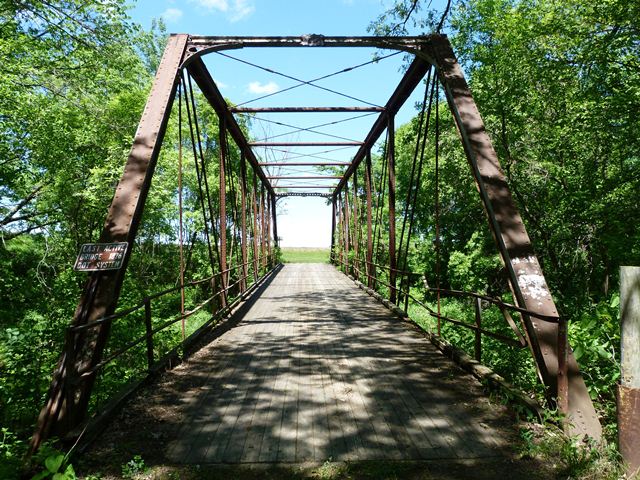We Recommend:
Bach Steel - Experts at historic truss bridge restoration.
Washington Park Bridge
CR-102 MN-22 Bridge

Primary Photographer(s): Nathan Holth
Bridge Documented: June 2, 2013
Rural: Le Sueur County, Minnesota: United States
Not Available or Not Applicable
115.8 Feet (35.3 Meters)
118.8 Feet (36.2 Meters)
16 Feet (4.88 Meters)
1 Main Span(s)
4846

View Information About HSR Ratings
Bridge Documentation
View The National Register of Historic Places Nomination Form For This Bridge
This bridge is the oldest highway Pratt truss in Minnesota. It has been relocated twice in its life. It was originally built over the Blue Earth River just south of Vernon Center in Blue Earth County. In 1928, the bridge was replaced and was reused as a highway over trunk highway overpass, carrying CR-102 over MN-22 in Kasota Township (La Sueur County). More recently, some time after its listing in the National Register of Historic Places in 1981, it was relocated to its current location in Washington Park.
Built in the 1870s when iron bowstring truss bridges were all the rage in highway construction, this pin-connected Pratt truss was a few years ahead of when this bridge type was most common. Bowstrings died out almost completely and almost immediately after 1880, allowing pin-connected Pratt truss bridges to become the dominant form of metal highway bridge. As a bridge built in 1975, it has a lot of unusual, non-standard details that was typical of bridges built before 1880. These include most unusual struts that are composed of plate rolled and riveted together to form a tube. The portal bracing is ornately designed of cast iron. The bridge has unusual cast iron feet that act as bearings and also attachments for lateral bracing. The cast iron plaques on the bridge portals frustratingly only lists a construction date. Although this bridge's distinctive portal bracing and struts undoubtedly were the unique production of a particular bridge company, no other known examples of bridges with these details exist, so it is not possible to associate a builder based on style at this time. Future research might reveal a builder however.

Above: This photo from the Minnesota Historical Society shows the bridge in its second location as an overpass.
![]()
Photo Galleries and Videos: Washington Park Bridge
Bridge Photo-Documentation
Original / Full Size PhotosA collection of overview and detail photos. This gallery offers photos in the highest available resolution and file size in a touch-friendly popup viewer.
Alternatively, Browse Without Using Viewer
![]()
Bridge Photo-Documentation
Mobile Optimized PhotosA collection of overview and detail photos. This gallery features data-friendly, fast-loading photos in a touch-friendly popup viewer.
Alternatively, Browse Without Using Viewer
![]()
Maps and Links: Washington Park Bridge
To access this bridge, drive straight down the park road and stop near where it dead ends. Walk back behind the building in the grass and follow the treeline until you reach the bridge.
Coordinates (Latitude, Longitude):
Search For Additional Bridge Listings:
Bridgehunter.com: View listed bridges within 0.5 miles (0.8 kilometers) of this bridge.
Bridgehunter.com: View listed bridges within 10 miles (16 kilometers) of this bridge.
Additional Maps:
Google Streetview (If Available)
GeoHack (Additional Links and Coordinates)
Apple Maps (Via DuckDuckGo Search)
Apple Maps (Apple devices only)
Android: Open Location In Your Map or GPS App
Flickr Gallery (Find Nearby Photos)
Wikimedia Commons (Find Nearby Photos)
Directions Via Sygic For Android
Directions Via Sygic For iOS and Android Dolphin Browser
USGS National Map (United States Only)
Historical USGS Topo Maps (United States Only)
Historic Aerials (United States Only)
CalTopo Maps (United States Only)

